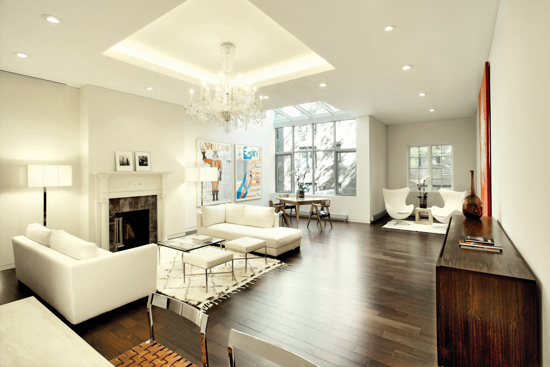|
||
 |
BY ELIZABETH STRIBLING, PRESIDENT, STRIBLING & ASSOCIATES NOVEMBER 1ST, 2008 |
Overnight, the world has turned topsy-turvy. Financial markets have plunged into turmoil. Eminent institutions such as Bear Stearns, Lehman Brothers and Merrill Lynch have collapsed or have been forced into shotgun weddings. Fannie Mae and Freddie Mac were placed into conservator ships by the government. The insurance giant AIG almost failed, only to be rescued by a government infusion of money. Wells Fargo purchased Wachovia, and Washington Mutual was absorbed into JP Morgan Chase. The Treasury Department leapt into the fray with a $700 billion financial rescue fund. Amidst such startling news, how is the New York City residential real estate market riding the tides of these turbulent times? New York is known as a Wall Street town. It is the headquarters of the above mentioned former investment banks as well as AIG. Surely, the toll on residential sales will be felt as mergers occur, the inevitable layoffs grow, and the fear factor mounts. Where is the residential market today? What is the prediction for the near future?

The Sales Market Has Slowed, But Not Stopped
Let me immediately say that we are in a period of pause but not of standstill. Sales are occurring. Although many potential buyers are waiting or reflecting, others, clearly more confident, are plunging ahead and buying. Deal by deal, the residential market continues. There will be some sellers who will be forced to sell due to relocation, job loss, or the need for liquidity. At the same time, there are buyers, jittery about the ups and downs of the stock market and the safety of money market funds, who are betting on bricks and mortar for an interim period.
The fear factor prompts different reactions. Certain sellers may choose to place their properties up for sale due to concerns that capital gains taxes will increase. Those who have been contemplating a sale in the next year or two, such as empty nesters, may decide to seize the moment and sell now. Others will simply ride a down cycle out before selling. It is too early to track any discernable trends. That said, the market is not being flooded with new inventory, nor are all buyers abandoning their search for the apartment of their dreams. In short, it is a much quieter market reflecting a period of evaluation and prudence.
Let me cite but a few examples of real estate deals that went into contract at Stribling during the rocky period of mid-September to mid-October, 2008. On Monday, September 15th, 2008, the very day when Merrill Lynch announced that it would be acquired by Bank of America and Lehman Brothers declared bankruptcy, a residential deal was struck at $14 million for a glamorous Fifth Avenue seven room cooperative in the low 60's. Yes, the buyer was a foreigner. That same week, a $449,000 listing was bid up to over $460,000 for a three room cooperative in a walkup building in Chelsea, perhaps an even more startling bread and butter deal. Good business as usual.
In the last weeks of September, two coveted Manhattan properties were listed for sale; both sold within a week at practically the full asking price. The first was a seven room cooperative apartment on a high floor in a prime Carnegie Hill Park Avenue building in the mid-$3 million range. It was snapped up. A week later, the buyer had cold feet; two days later the contract was signed. Concurrently, another seven room cooperative was listed in a gold coast Central Park West building facing the park. It went to contract immediately at close to the mid- $5 million asking price. It was purchased pre-emptively by a neighbor. Both properties were sought after listings in a size range where inventory is practically nonexistent.
Further downtown, a Tribeca condominium penthouse entered into contract in the first two weeks of October at over $5 million. In Brooklyn, a three bedroom condominium in Park Slope taken off the market for a slight renovation last summer, was relisted at an increased asking price of $1.6 million. It sold promptly at full price. In another instance, an especially motivated seller in the East 70's, who was relocating chose to price his two bedroom cooperative at a lowball figure of $775,000 in order to achieve a very quick sale. Within the week, there were three bidders, and he entered into contract at an over-ask bid of $810,000. On the other hand, during this same time frame there were buyers who attempted to renegotiate existing deals based on the declining financial markets. Some succeeded. Others did not. Still other buyers chose to put their search on hold. It is a case-by-case decision. It is a deal-by-deal market.

Up To This Point, Statistics Show Stability
If we are entering a changing real estate market, as most predict, where are we today? What is our departure point? According to the recently released report of Miller Samuel Inc., the average price of a Manhattan apartment actually rose slightly in the third quarter of 2008 to $1,480,363 from the prior year quarter average sales price of $1,369,486. However, this 8.1% quarter-to-quarter increase was down from the first quarter 2008 average of $1,722,991. Although the Miller Samuel report shows that inventory of available properties has increased 34.6% over the prior year quarter, this increase in listings reflects the historic low level of inventory in 2007 due to the record high level of sales activity during that same period.
The actual number of listings that entered the market from August to September of 2008 rose 14.9%, which was consistent with the 12% increase in listings from the same period in 2007. Please note that these statistics in no way reflect the potential impact of the current financial crisis, but reflect deals struck months ago that closed during this quarter. The Miller Samuel report also saw the average time on the market of a listing until contract signing rise by a little over a week from the prior year's quarter to a total of 134 days. This increased time period partially reflects the fact that mortgages are much harder and more expensive to obtain today as credit markets have tightened. Inventory levels, although rising, continue to be at a modest level. In addition, the present credit contraction will dictate a hold on new condominium developments which in turn will maintain a lid on rising inventory. Thus, with the average price of a Manhattan apartment at just under $1.5 million and a relatively low level of overall inventory, the market appears to be on a relatively stable foundation as we move forward. Much will depend on the future flow of credit.
How The Mortgage Market Has Changed
Credit is key. In the aftermath of the sub-prime mortgage meltdown, banks have become much more rigorous in individual credit review, and have tightened their lending guidelines dramatically. Gone are the days of easy 80% bank financing on practically any residential transaction.
Today, as credit markets tighten, it is especially difficult for first time purchasers to obtain an affordable mortgage without making a substantial cash investment. Let me quickly add that mortgage money is readily available for those with a stellar credit rating. Impeccable credit scores or an excellent long term credit history are the new gold standards. With 800 as the ten of the rating system, a score of over 740 is the new guideline for maximum financing at the best terms.
Although mortgage funds are obtainable for those who do not merit near perfect scores, the premium paid can be huge. Banks demand either a higher percentage of cash, in some instances as much as 40% for a jumbo loan, or a higher mortgage rate, or both. In addition, in many instances a buyer must first sell his or her property before even being considered for a loan on a future property. Even with a bank commitment letter in hand, troubling surprises can occur. If a buyer's credit rating falls, or if the building in which the purchase is to occur does not have enough units sold or in contract, some banks may require a higher percentage of cash to close.
To make matters even worse, banks as well as strict cooperative boards have increased their demand for post closing cash reserves. This can be especially burdensome for first time buyers. Many banks and cooperatives insist on post closing reserves as high as the equivalent of two to three years in combined mortgage and maintenance payments.
How does the average buyer manage? What is the recourse? In more and more instances, it is Mom and Dad, relatives and friends who are being asked to spring to the rescue. Whether it is a gift, a loan, or a guarantee, personal financing is often the only solution to raise the needed cash for down payments, closing costs, additional cash requirements, or reserve liquidity. With tightened credit, and rigorous cooperative board review, many buyers are going the old fashioned route and relying on what always counts the most, family and friends. Not surprisingly, most lawyers are advising their clients to put the terms in writing to avoid any future broken fences that might necessitate painful mending.

How Should Sellers Price Their Home Now?
If credit is the principal issue for many of today's buyers pricing is the new challenge for sellers. How do you properly price your dwelling in a changing market? The latest quarterly statistics reflect deals struck months ago. Proper pricing is always key to a successful sale. How do you begin?
- First of all, in consultation with a recommended broker, review the most immediate sales in your building or neighborhood. Make an unbiased list of the pros and cons of your property versus those that have recently sold: high or low floor, excellent or average condition, full serviced building or partially serviced, sunny or dark, etc.
- Choose a fair price based not only on recent sales but on current offerings. These listings are your competition. Consult with your broker: are these listings over priced, or in line with the majority of other listings on the market?
- Be analytical and not subjective. A home is a reflection of personality. However, taste is relative; do not allow emotion to enter into your equation.
- Price your property fairly and you will be ahead of the curve. Proper pricing always attracts buyers who have already made a careful study of the market. An overly ambitious price will only cause a property to languish allowing other listings to be placed up for sale that create additional competition.
- Do not chase the market down. Take the lead. Evaluate, and price fairly. You will succeed in selling. As I have said, there are buyers in the market today. Deals are being struck all over town.
Inventory, Though Higher, Is Still At A Historically Low Level
Proper pricing will result in sales. On a broader scale, it also will maintain inventory levels. Inventory indicates the health of a residential sales market. A low level of inventory generally is a sign of a robust market where demand outstrips supply. A rising level of inventory often signals a changing market where demand is on the decrease. As stated previously, the current third quarter market statistics reveal a 34% increase in inventory over the prior year quarter, but with the telling caveat that inventory levels in 2007 were at historic lows resulting in an actual exaggeration of the percentage rise. What changed in 2008 was a 26% decrease in the volume of sales in the year to date versus the same time last year.
Indeed, sales activity is down; properties are staying on the market longer. The inevitable result is an increase in inventory. That said, from a historic perspective, inventory remains at a modest level. Furthermore, with the credit contraction there will be a hold on new condominium development. For new development, it generally takes at least two years from concept to closing. As credit began to tighten for development lending in 2007, and 2008 has brought such lending to a dead standstill, there will be virtually no new future development projects on the market until the end of 2010 or 2011. Condominium buyers seeking brand new construction will have to buy now or wait the cycle out. In fact, the market share of current development inventory has dropped from 28.5% of all listings in the third quarter of 2007 to 26.9% in the same quarter of 2008 due to market absorption of this product.
Today, there is nowhere near the glut of properties that flooded the market in the early 1990's. In the 1980's, developers created thousands of new apartments due to tax incentives. During the same period, countless rental buildings were converted to cooperatives. Many of these apartments were small units that were sold to investors who subsequently had to unload them after the stock market crash of 1987. Today, data demonstrates that fewer units have been built which also vary greatly in size. Although investors have purchased many of these units the majority of recent development projects are owner occupied which reflects a much more solid market.
A Changing Market May Bring A Buying Opportunity
Resale inventory has been low over the last several years. Growing families have avidly competed for classic six room apartments as well as larger three and four bedroom apartments. Today, even if some buyers have opted to wait and see, there is still a demand for such properties.
Indeed, buyers who are still in the market may profit from a chance to acquire a newly listed property that previously was rarely obtainable. Equally, condominium buyers may benefit from a variety of concessions that are being offered by condominium developers who find themselves faced with a more challenging market.
Concessions vary from project to project. Offering plan prices generally hold firm. However, perks can equate to major dollars. In some instances, developers are offering seller financing at affordable rates. Other developers may offer to pay transfer taxes or mortgage points to reduce the interest rate for buyers. Such concessions are generally only offered to serious buyers who are actively bidding on a unit. For astute buyers, a changing market may produce excellent deal-by-deal opportunities.

Quality Stands Out Whatever The Market
For those who seek the exceptional, and for whom credit poses no problem there is an exciting new downtown development with an ambiance all of its own offered by Stribling Marketing Associates. Look no further than 350 West Broadway, in the heart of Soho between Grand and Broome Streets, for a unique blend of cutting edge chic in an art infused environment.
Construction is underway on this brand new ten story building which will be sheathed in energy efficient, ultraclear insulated glass. Designed by renowned architects Moed de Armas & Shannon, there will be 10,000 square feet of retail space on two floors at the base of the building that will be topped by eight full floor residential units ranging from 2,875 square feet to 3,539 square feet most with outdoor spaces. Developed by Aby Rosen of RFR Holding LLC, 350 West Broadway is envisioned as a micro-scale version of the landmark Lever House at 390 Park Avenue which is owned by Rosen.
With a nod to the classicism of traditional Park Avenue apartment layouts, 350 West Broadway will feature spacious entry foyers, separate service entrances, and full sized laundry rooms. At the same time, the latest high tech and electronic systems will offer up-to-the-moment amenities such as zoned Lutron lighting and shades, programmable Creston thermostats, and an audio-visual system by Sound Sight Technologies.
Perhaps the most arresting spin that 350 West Broadway brings to luxury living will be its art filled lobby. William Georgis, dubbed one of the Top 100 architects by Architectural Digest magazine, has designed a one-of-akind lobby to showcase works by three celebrated artists. American artist George Condo has created an exuberant colorful painting, his first for a condominium project, which will be complemented by Seabed, a large scale ceramic by Peter Lane.
Elaborate bronze door pulls by Soho artist Michelle Oka Doner will provide stunning accents for this impressive lobby which will also feature fumed oak floors, Vermont Cold Spring Black Granite, and lacquered panels on the walls. The Georgis — designed interiors will provide privacy in the entertaining areas with the installation of stone sheaths that not only accent the glass panels on the building's facade, but provide wall space for furniture placement.
350 West Broadway is scheduled for fall 2009 occupancy, with prices starting at $9.575 million. Betting on the continued strength of the luxury high end market Aby Rosen is developing eight unique art infused environments for a mere handful of top end buyers.
This elite group of buyers may soon have more offerings to tempt them. Last year, listings were so scarce that private deals were struck at cocktail parties. Today, perhaps prompted by grim financial news, trophy listings are once again beginning to come on the market. In mid- October a beautiful eleven room duplex cooperative was offered at the prestigious cooperative building, One Sutton Place South, with an asking price of $12.5 million. Across the park at the Majestic the aptly named cooperative with soaring twin towers at Central Park West and West 72nd Street, two three bedroom apartments were listed on the very same day in late October. One is a triple mint nine room apartment with three bedrooms plus a library and solarium which is asking $13.95 million. The second apartment is a smaller seven room apartment in equally excellent condition with three bedrooms and an asking price of $7.75 million. Both apartments have sweeping views over Central Park, always a sought after feature which commands a premium.
Counting both new development and resale offerings the real estate website Streeteasy.com reported that 27 apartments ranging from $10 million to $20 million were placed on the market from the end of September to the end of October, 2008. Will they sell at these prices? Will they be discounted? In today's troubled times are luxury listings going to continue to hold their value? Remember, it only takes one buyer to scoop up a prestigious property, and true luxury always comes at a price.

Where Is The Market Heading?
Clearly we are in uncharted times. In good markets, economists talk of a wealth effect. High home values make people feel good and financially secure. Even for those who have been fortunate enough not to personally experience the dire consequences of the sub-prime mortgage debacle, the resulting house of cards impact on overall global financial markets is bad news for all. Today, one hears of a poverty effect. Most unfortunately, it is a reality for many. With rising unemployment and reduced consumer spending the economy is on everyone's mind. In New York City, the woes of Wall Street are palpable. In 2007, Wall Street jobs, while only 5.8% of New York City's private sector employment, represented 23% of private sector wages. With predictions that Wall Street bonuses will fall by 50% from last year's $33.2 billion, tax revenues to both city and state will decrease. Much of this Wall Street bonus money was traditionally channeled into real estate. What will the impact of the loss of these bonuses be on the overall market? As housing prices have come down throughout much of the United States, will the time of reckoning finally arrive in New York City?
It is too soon to tell, and if so, by how much. Most importantly, financial markets have to stabilize. Credit must begin to flow. Confidence must be restored. In the interim, it will continue to be a deal-by-deal residential market in New York City. Let us hope that the public and private sectors can work together, both nationally and globally, to sort the current financial crisis out, and gradually emerge with solid fundamental values restored.

